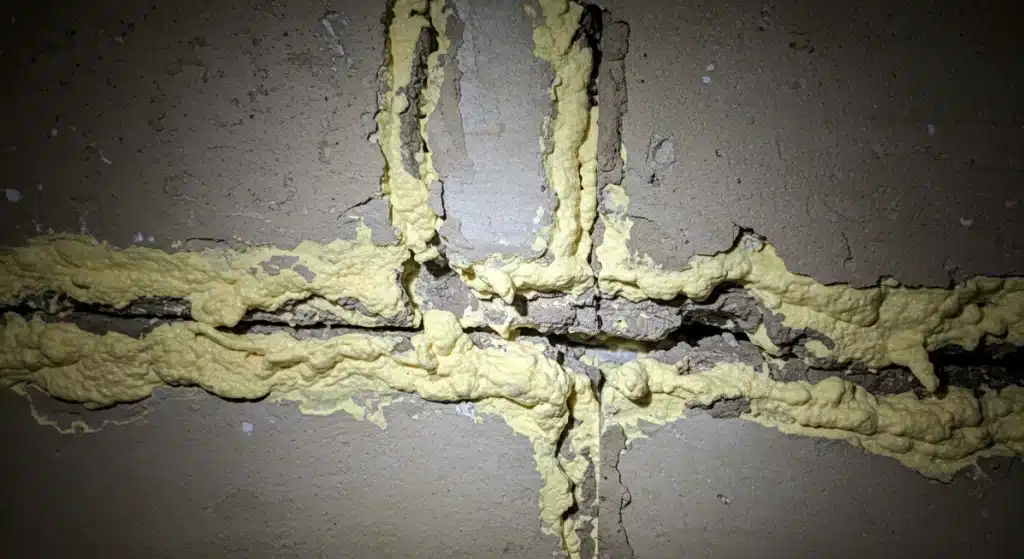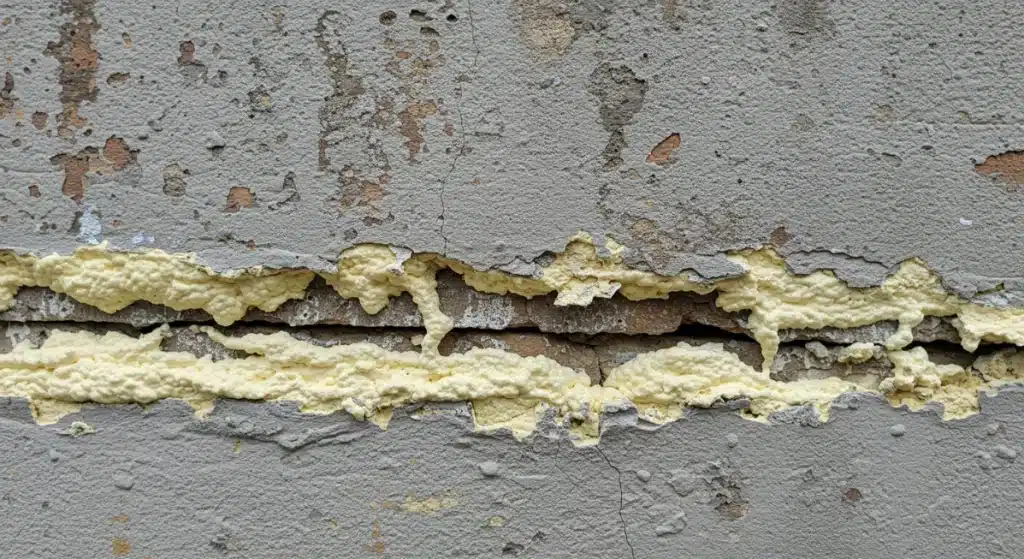Air leaks undermine the performance of spray foam insulation by allowing uncontrolled airflow through gaps and cracks. This weakens the thermal barrier, reduces energy efficiency, and causes long-term damage to the insulation itself. Sealing air leaks before spray foam repairs ensures full adhesion, uniform expansion, and lasting thermal control.
Spray foam requires a stable, enclosed environment to perform correctly. When air leaks are not addressed first, they introduce temperature differentials and moisture migration that distort foam curing. This often leads to voids, delamination, or misapplied foam—reducing the effectiveness of the repair. Proper application is especially critical in commercial insulation projects, where performance and durability are key to maintaining energy efficiency and building integrity.
This article outlines exactly why leak sealing matters, backed by field-tested insights and measurable data. All recommendations are based on direct experience with various insulation materials and techniques, including local conditions specific to Fresno and similar Central California climates.
Airflow Disrupts Foam Integrity
Why leaks affect spray foam application
Uncontrolled airflow can displace spray foam during application, preventing it from bonding to surfaces properly. This results in uneven coverage, reduced R-value, and vulnerability to moisture intrusion.
| Problem Caused by Unsealed Air Leaks | Consequence on Spray Foam Repairs |
|---|---|
| Air movement across substrate | Misaligned or displaced foam |
| Moisture intrusion through gaps | Compromised foam curing |
| Temperature swings near leaks | Shrinking or cracking over time |
| External dust/dirt entering cavity | Reduced foam adhesion |
Bonus Tip:
Use smoke pencils or infrared thermography to detect hidden leaks before beginning insulation work. This reduces guesswork and improves job quality.
Technical Conditions for Effective Foam Repair
Spray foam needs a stable substrate with no dynamic airflow or moisture loading. Here are the minimum technical conditions required for optimal repairs:
| Requirement | Acceptable Range or Condition |
|---|---|
| Substrate surface temperature | 60°F to 80°F (16°C to 27°C) |
| Relative humidity in cavity | < 50% |
| Air leakage through substrate | None detectable |
| Moisture content in wood surfaces | < 19% |
| Dust/debris on surfaces | Vacuumed or wiped clean |
Sealing gaps before applying foam helps meet these requirements and avoids installation failures.

Sealing First Saves Time and Money
Correcting spray foam failures caused by unsealed leaks is far more labor-intensive than addressing leaks upfront. The rework often requires full removal and replacement of foam sections.
Market Data:
- According to the Department of Energy, air leaks can account for 25-40% of total heat loss in homes with poor insulation (Source: energy.gov).
- Reapplication costs for failed foam projects in California range from $4.50 to $7.25 per sq ft depending on access difficulty and material type (Source: HomeAdvisor, 2024).
Bonus Tip:
Prioritize leak detection near rim joists, wall-plate connections, and around penetrations like vents and wiring. These areas are the most common culprits.
Local Climate and Environmental Relevance
Fresno’s hot summers and damp winters amplify the impact of air leaks. Spray foam repairs in this region must account for:
- High daytime attic temps (>120°F)
- Nighttime cooling with sharp thermal swings
- Persistent dust from agriculture and dry soils
These conditions cause stress on improperly installed foam and expose any weak seals.
Things to Consider Before Making a Decision
- Leak visibility: Surface cracks may be obvious, but hidden leaks require professional testing.
- Foam type: Closed cell foam offers air barrier properties, but only when installed correctly and on sealed substrates.
- Job scope: Large repairs involving multiple cavities must be preceded by a whole-home air sealing plan.
- Budget impact: Skipping leak sealing may reduce upfront cost but leads to long-term inefficiencies and callbacks.
Spray Foam Services Available
Supreme Spray Foam Fresno offers specific services that directly address issues related to air sealing and foam repairs:
- Spray Foam Repairs: Targeted remediation of damaged or underperforming foam insulation.
- Closed Cell Spray Foam Insulation: High-density insulation with superior air and vapor barrier properties.
- Attic Insulation: Solutions designed for high-heat environments common in Central California.
- Crawl Space Spray Foam Insulation: Sealing and insulating understructures prone to drafts and moisture.
Common Questions About Sealing Before Spray Foam
How do I know if my home has air leaks?
Use blower door testing or smoke tests to identify leakage points. Common spots include window frames, wall intersections, and attic hatches.
Can spray foam seal leaks on its own?
Not reliably. It may reduce airflow, but without pre-sealing, foam can trap moisture and fail to adhere correctly.
Is leak sealing always necessary before foam repairs?
Yes. Without it, foam performance drops significantly, especially in humid or high-temperature zones like Fresno.
What’s the best way to seal leaks before insulation?
Use caulks, foam backer rods, or rigid sealing tape depending on the size and location of the gap. Ensure all surfaces are dry and clean.
Get Expert Insulation Guidance
To get the best performance from spray foam repairs, address air leaks before installation. Supreme Spray Foam Fresno offers practical guidance and field-tested insulation services across Central California.
Phone: (559) 545-0800 Email: [email protected]
FAQ
How long should you wait after sealing before spraying foam?
Wait until all sealants have fully cured—usually 24 hours. Check product specs for exact curing times.
Does air sealing affect indoor air quality?
Yes. By controlling airflow, you reduce dust, allergens, and moisture-related mold risks.
Can HVAC systems affect air leak detection?
Yes. Ensure systems are off during testing to avoid pressure distortions.
Is it possible to retrofit sealant under existing insulation?
In some cases. But for precision, removal of old insulation may be required to access and seal the gaps effectively.
Does sealing leaks reduce energy bills?
Yes. Proper sealing combined with foam insulation can cut heating and cooling costs by up to 30% (Source: EPA ENERGY STAR, 2023).


